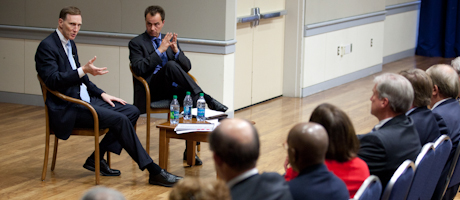The Transportation Security Administration (TSA) has implemented significant changes to airport security in the decade since Sept. 11, a day which required TSA to evolve into a “high-performing counter-terrorism organization,” said TSA administrator John Pistole in a Nov. 11 address at GW.
“For those of in the industry, it didn’t take long—seconds, really—to understand that air travel [after 9/11] would be changed in the foreseeable future,” said Mr. Pistole.
In his remarks in GW’s Marvin Center, Mr. Pistole highlighted the advances of TSA technology and layers of security over the last decade and noted several recent enhancements to security, including new privacy protections in advanced imaging technology (AIT) machines.
Since its inception, TSA has screened more than 5 billion people.
The address and a question-and-answer session was hosted by Homeland Security Policy Institute and moderated by its director, Frank Cilluffo, associate vice president for homeland security.
In his introduction, Mr. Cilluffo noted that Mr. Pistole has one of the most “complex, challenging and difficult” jobs in Washington, D.C. As TSA administrator, Mr. Pistole oversees 60,000 employees; the security operations of more than 450 federalized airports throughout the U.S.; the Federal Air Marshal Service; and security for highways, railroads, ports, mass transit systems and pipelines.
Mr. Pistole first outlined the milestones in airport security since 9/11. Through the Secure Flight Program, TSA matches 100 percent of all passengers flying into, out of and within the United States against the U.S. government watch list. TSA also screens 100 percent of cargo on domestic passenger planes and 100 percent of high-risk international inbound cargo on passenger planes.
Mr. Pistole said TSA’s most significant enhancement is the implementation of more than 2,000 Explosive Detection System machines in approximately 100 airports in the U.S.
He also spoke about TSA’s use of AIT machines since 2007, which he said gives them “the best opportunity to detect both metallic and non-metallic threats.”
He said TSA has confiscated hundreds of prohibited, dangerous or illegal items concealed on passengers due to AIT and showed the audience pictures of some of the most recently confiscated items, including cocaine, firearms and knives.
Mr. Pistole also noted that TSA recently implemented privacy protections on millimeter wave AIT machines. The “automated target recognition” software will provide officers with a generic outline of persons, rather than an individual outline.
“As we work with the manufacturers and industry to increase protection capabilities—which is always important to do with the evolving threats— we need to make sure that we’re doing the best possible job of protecting the privacy and civil liberties of the traveling public,” said Mr. Pistole.
Mr. Pistole also mentioned several other layers of security, including the use of canine units, Federal Air Marshals and random gate screenings.
“Clearly aviation security is much more advanced, much more thorough than it was 10 years ago,” he said, “and we continue to push industry to come up with the best technology available that we can use, along with our multiple layers of security, across the 450 airports in the U.S. that we have responsibility for.”
In the next decade, Mr. Pistole said he wants TSA to move into a more “risk-based, intelligence-driven security approach” to continue addressing evolving threats, and detailed several new security and screening programs being tested in airports around the U.S.
One of these new initiatives, the “TSA Pre-Check program,” allows flyers to enroll in a pre-screening program in order to expedite their travel. The program is currently being tested at international airports in Atlanta, Detroit, Dallas/Fort Worth and Miami, with domestic frequent flyers from American Airlines and Delta Air Lines as well as members of the Customs and Border Protection’s Trusted Traveler programs.
More than 50,000 flyers have already gone through the program, and Mr. Pistole said TSA hopes to expand the program to international airports in Las Vegas, Los Angeles and Minneapolis-St. Paul in the next several months.
“As we begin our second decade of service, we at TSA remain focused on and committed to the core mission,” he said, “which is to secure the freedom of people and goods.”


